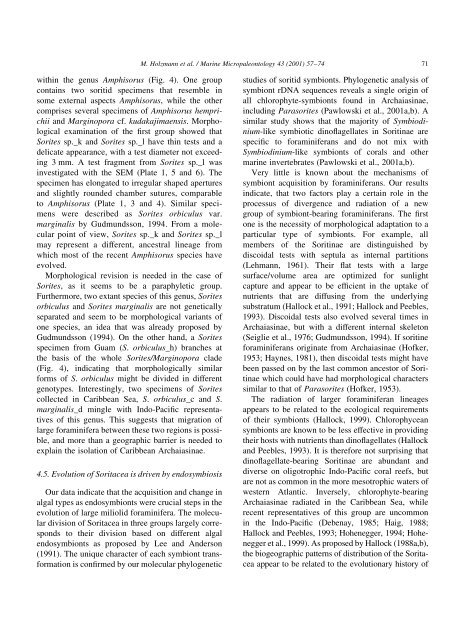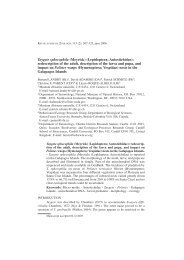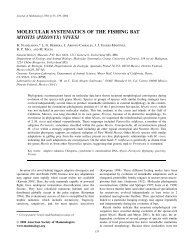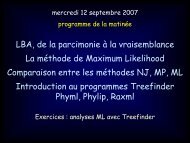Molecular phylogeny of large miliolid foraminifera - University of ...
Molecular phylogeny of large miliolid foraminifera - University of ...
Molecular phylogeny of large miliolid foraminifera - University of ...
You also want an ePaper? Increase the reach of your titles
YUMPU automatically turns print PDFs into web optimized ePapers that Google loves.
M. Holzmann et al. / Marine Micropaleontology 43 2001) 57±74 71within the genus Amphisorus Fig. 4). One groupcontains two soritid specimens that resemble insome external aspects Amphisorus, while the othercomprises several specimens <strong>of</strong> Amphisorus hemprichiiand Marginopora cf. kudakajimaensis. Morphologicalexamination <strong>of</strong> the ®rst group showed thatSorites sp._k and Sorites sp._l have thin tests and adelicate appearance, with a test diameter not exceeding3 mm. A test fragment from Sorites sp._l wasinvestigated with the SEM Plate 1, 5 and 6). Thespecimen has elongated to irregular shaped aperturesand slightly rounded chamber sutures, comparableto Amphisorus Plate 1, 3 and 4). Similar specimenswere described as Sorites orbiculus var.marginalis by Gudmundsson, 1994. From a molecularpoint <strong>of</strong> view, Sorites sp._k and Sorites sp._lmay represent a different, ancestral lineage fromwhich most <strong>of</strong> the recent Amphisorus species haveevolved.Morphological revision is needed in the case <strong>of</strong>Sorites, as it seems to be a paraphyletic group.Furthermore, two extant species <strong>of</strong> this genus, Soritesorbiculus and Sorites marginalis are not geneticallyseparated and seem to be morphological variants <strong>of</strong>one species, an idea that was already proposed byGudmundsson 1994). On the other hand, a Soritesspecimen from Guam S. orbiculus_h) branches atthe basis <strong>of</strong> the whole Sorites/Marginopora cladeFig. 4), indicating that morphologically similarforms <strong>of</strong> S. orbiculus might be divided in differentgenotypes. Interestingly, two specimens <strong>of</strong> Soritescollected in Caribbean Sea, S. orbiculus_c and S.marginalis_d mingle with Indo-Paci®c representatives<strong>of</strong> this genus. This suggests that migration <strong>of</strong><strong>large</strong> <strong>foraminifera</strong> between these two regions is possible,and more than a geographic barrier is needed toexplain the isolation <strong>of</strong> Caribbean Archaiasinae.4.5. Evolution <strong>of</strong> Soritacea is driven by endosymbiosisOur data indicate that the acquisition and change inalgal types as endosymbionts were crucial steps in theevolution <strong>of</strong> <strong>large</strong> <strong>miliolid</strong> <strong>foraminifera</strong>. The moleculardivision <strong>of</strong> Soritacea in three groups <strong>large</strong>ly correspondsto their division based on different algalendosymbionts as proposed by Lee and Anderson1991). The unique character <strong>of</strong> each symbiont transformationis con®rmed by our molecular phylogeneticstudies <strong>of</strong> soritid symbionts. Phylogenetic analysis <strong>of</strong>symbiont rDNA sequences reveals a single origin <strong>of</strong>all chlorophyte-symbionts found in Archaiasinae,including Parasorites Pawlowski et al., 2001a,b). Asimilar study shows that the majority <strong>of</strong> Symbiodinium-likesymbiotic dino¯agellates in Soritinae arespeci®c to <strong>foraminifera</strong>ns and do not mix withSymbiodinium-like symbionts <strong>of</strong> corals and othermarine invertebrates Pawlowski et al., 2001a,b).Very little is known about the mechanisms <strong>of</strong>symbiont acquisition by <strong>foraminifera</strong>ns. Our resultsindicate, that two factors play a certain role in theprocessus <strong>of</strong> divergence and radiation <strong>of</strong> a newgroup <strong>of</strong> symbiont-bearing <strong>foraminifera</strong>ns. The ®rstone is the necessity <strong>of</strong> morphological adaptation to aparticular type <strong>of</strong> symbionts. For example, allmembers <strong>of</strong> the Soritinae are distinguished bydiscoidal tests with septula as internal partitionsLehmann, 1961). Their ¯at tests with a <strong>large</strong>surface/volume area are optimized for sunlightcapture and appear to be ef®cient in the uptake <strong>of</strong>nutrients that are diffusing from the underlyingsubstratum Hallock et al., 1991; Hallock and Peebles,1993). Discoidal tests also evolved several times inArchaiasinae, but with a different internal skeletonSeiglie et al., 1976; Gudmundsson, 1994). If soritine<strong>foraminifera</strong>ns originate from Archaiasinae H<strong>of</strong>ker,1953; Haynes, 1981), then discoidal tests might havebeen passed on by the last common ancestor <strong>of</strong> Soritinaewhich could have had morphological characterssimilar to that <strong>of</strong> Parasorites H<strong>of</strong>ker, 1953).The radiation <strong>of</strong> <strong>large</strong>r <strong>foraminifera</strong>n lineagesappears to be related to the ecological requirements<strong>of</strong> their symbionts Hallock, 1999). Chlorophyceansymbionts are known to be less effective in providingtheir hosts with nutrients than dino¯agellates Hallockand Peebles, 1993). It is therefore not surprising thatdino¯agellate-bearing Soritinae are abundant anddiverse on oligotrophic Indo-Paci®c coral reefs, butare not as common in the more mesotrophic waters <strong>of</strong>western Atlantic. Inversely, chlorophyte-bearingArchaiasinae radiated in the Caribbean Sea, whilerecent representatives <strong>of</strong> this group are uncommonin the Indo-Paci®c Debenay, 1985; Haig, 1988;Hallock and Peebles, 1993; Hohenegger, 1994; Hoheneggeret al., 1999). As proposed by Hallock 1988a,b),the biogeographic patterns <strong>of</strong> distribution <strong>of</strong> the Soritaceaappear to be related to the evolutionary history <strong>of</strong>






